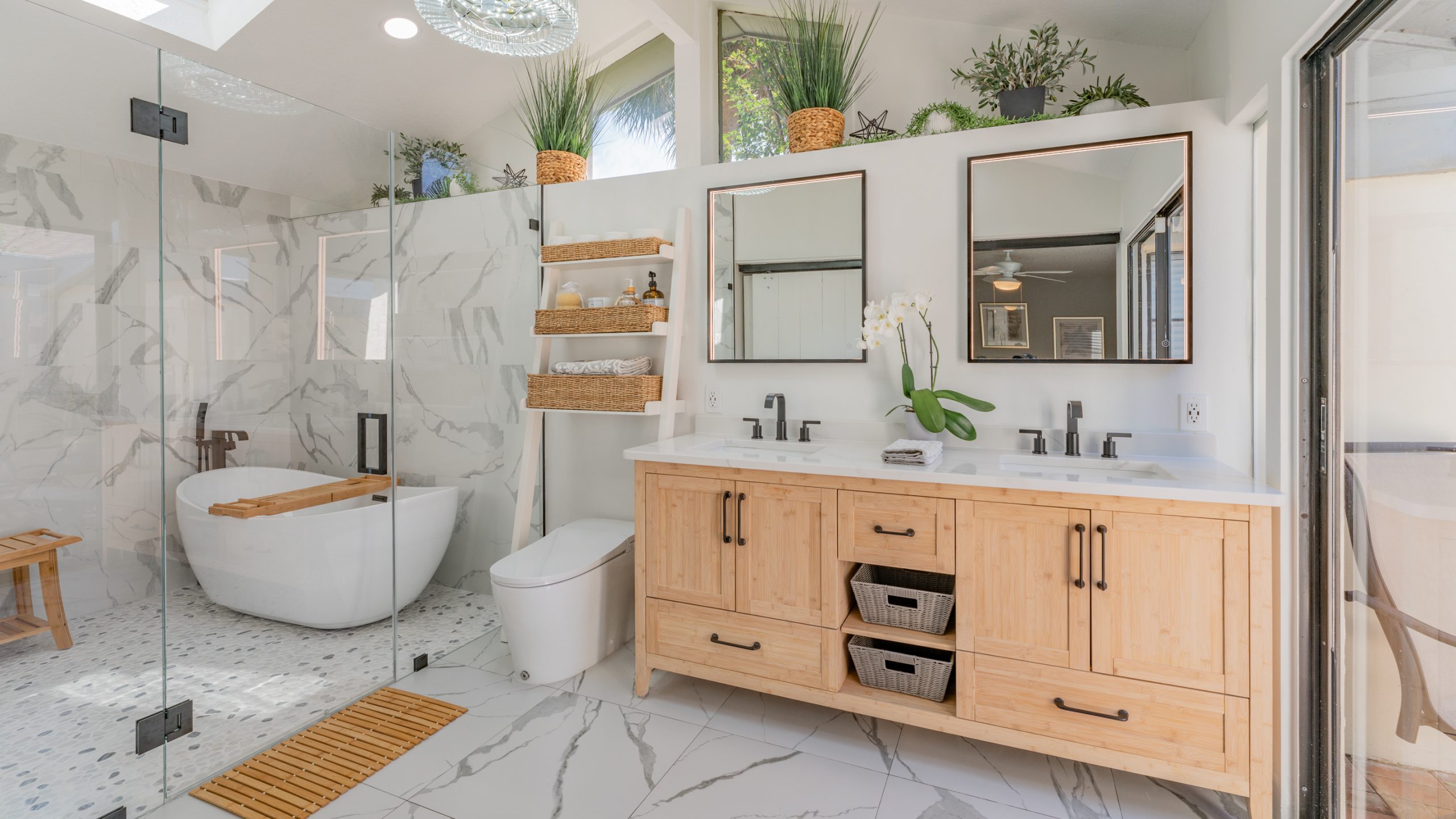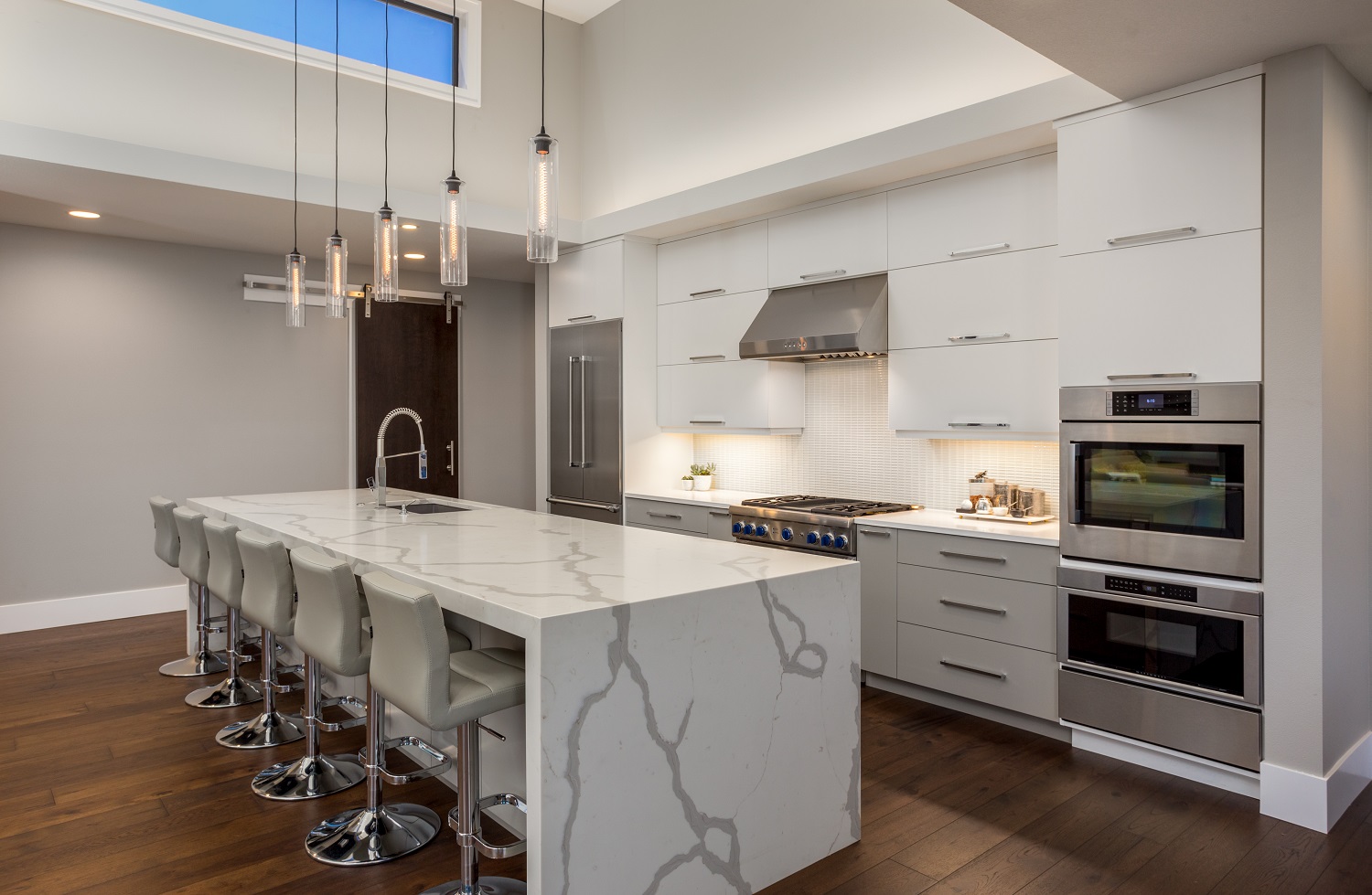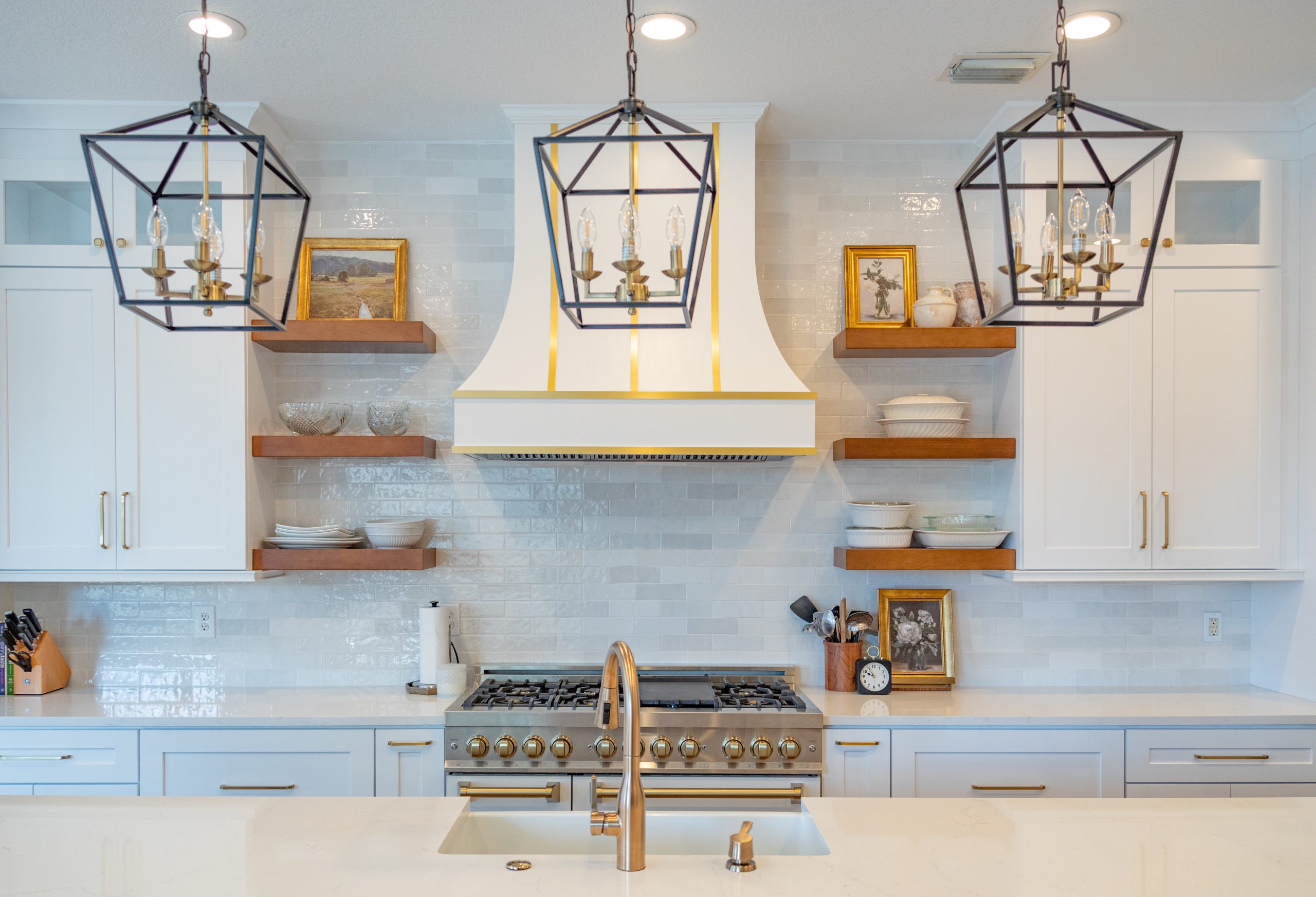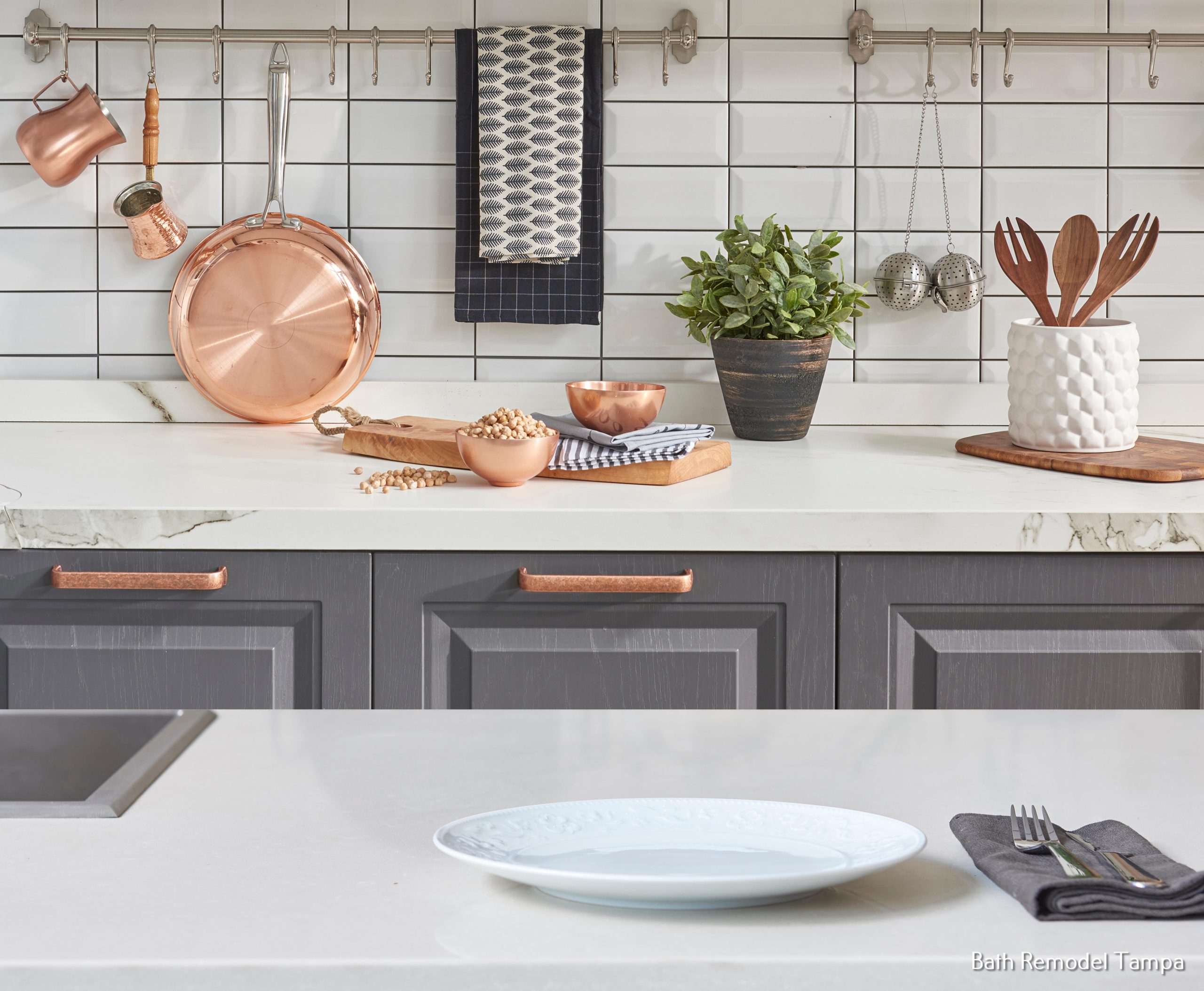
2023 Bathroom Trends: The Hottest Styles and Designs for Your Home
Remember the days when bathroom redesign was synonymous with shabby chic, industrial, or traditional designs? 2023 has flipped that script entirely. Imagine soaking in a smart tub while gazing at the stars through a glass ceiling. How about asking Alexa to adjust your mirrored vanity light’s intensity or set the optimum temperature of your shower water? This isn’t an episode from The Jetsons—this is the reality of home design in 2023. Bathrooms have not just become technologically ahead; they’ve leaped into the future altogether. Breathe life into your most private space with the hottest bathroom trends of 2023 we’re about to uncover.
Some of the top bathroom trends for 2023 include clean lines, easy-to-clean and maintain materials, natural colors, personalization, and a focus on health, wellness, and relaxation. Other popular trends include larger and more customized showers, walk-in showers with visually stunning wall tiles and glass enclosures, open shelves for displaying luxury towels, and incorporating greenery to help create a serene space. Homeowners are also seeking out unique natural stones for their sink countertops and expanding or adding easy-to-use solutions like steam showers or heated floors to their bathrooms.
Dominant Trends in 2023 Bathroom Designs
In 2023, bathroom designs will continue to evolve, with a focus on clean lines, easy-maintenance materials, and natural colors. But more importantly, the trend is shifting our view of bathrooms from task-focused spaces to rooms designed for comfort focused on health, wellness, and relaxation.
As homeowners spend more time in their homes due to recent events, designers are adapting to create a sanctuary-like space within the bathroom. In turn, personalization is driving many of the design choices as homeowners seek to create comfortable rooms with custom bathing experiences.
One of the dominant trends in 2023 bathroom designs will be the incorporation of spa-inspired features such as steam showers and aromatherapy. This trend reflects a growing desire among homeowners for luxurious, relaxing experiences within their homes.
Another key trend is accessibility. Designing showers that cater to all ages using zero-entry technology has become very popular. Shower seats to accommodate different needs have also been designed into shower areas to ensure accessibility for all while maintaining an aesthetically pleasing look.
At the forefront of this shift towards comfort and wellness is ‘smart’ technology. Advancements include new lighting systems that allow you to adjust color temperatures throughout the day or respond automatically to natural light levels. New intelligent shower systems take the chore out of creating your perfect routine and can be controlled via your phone or voice-activated devices.
This shift in bathroom design creates opportunities for imaginative and unique offerings that better meet homeowners needs by optimizing, beyond just function, comfort-oriented features and wellness benefits within their homes.
The next section explores how personalization positively influences the shift toward designing rooms promoting health, wellness, and relaxation within bathrooms in 2023.
Personalization and Comfort
The attention to 2023 bathroom design is not limited strictly to functionality but includes aesthetics that cater to individual preferences, lifestyles, and aspirations. Clients value unique and visually pleasing spaces that reflect their personal style as much as a comfortable and healthy experience.
Natural stones like white marble create unique visual interest while bringing practicality to low-maintenance surfaces across fixtures and counters in the design of a bathroom. standing tubs remain popular for creating a centerpiece within luxurious bathroom retreats.
Texture is becoming more important to clients than color, with mixed materials and textures providing warmth in a space made up of hard surfaces. Homeowners are also prioritizing statement pieces of bold natural marble veining and incorporating unique wall tiles with contrasting colors and textures into their bathrooms.
Personalization is driving the need for homeowners to create comfortable rooms with custom bathing experiences. One solution to achieving maximum comfort is to reduce noise levels while installing elements that promote relaxation. Incorporating greenery such as bamboo or natural wood finishes on flooring offers a level of tranquility without compromising luxury choices.
As personalization influences the trend toward designing bathrooms that promote wellness and relaxation in 2023, designers are encouraged to integrate user preferences into their designs to align with the values of each homeowner’s family life. With this shift towards personalization, however, it becomes essential to balance style and functionality as much as, if not more than, the importance we place on beauty when designing our sanctuary bathrooms.
Focusing on comfort does not mean that small details can’t provide modern conveniences. Every detail should be well thought out so that it is useful without compromising aesthetics. Designers’ challenge lies in striking a balance between individual preferences for quality living, functional design features like anti-slip floors, grab bars, or raised toilet seats, and universal design principles for safety and accessibility considerations necessary for their homes.
In finding this balance, personalization can become genuine if expertly executed by skilled professionals. Forego copying DIY ideas from the internet when creating a personalized and comfortable bathroom and rather trust in an expert designer’s ability to achieve multiple functionalities. The next section discusses how elevated shower experiences are advancing towards offering ultimate comfort-oriented features.
Health, Wellness, and Relaxation Focus
Bathroom design in 2023 is all about focusing on health, wellness, and relaxation. Bathroom spaces are no longer just a functional space where one comes to complete necessary tasks but have now been transformed into a spa-like experience that caters to the homeowner’s overall wellbeing. Incorporating natural elements, such as light and greenery, can help create an ambiance that fosters relaxation.
The incorporation of elements like aromatherapy into bathrooms has become increasingly popular. The use of fragrant oils in steam showers has been known to help soothe muscles and promote relaxation. Adding a high-quality sound system, including speakers and calming music playlists, takes this experience to another level.
Customization will remain the driving force behind bathroom design in 2023. With a focus on creating custom bathing experiences for homeowners, bathroom designs are tailored to meet their needs. Personalization allows homeowners to create comfortable rooms that cater to their unique style and preferences while also promoting relaxation.
Natural stones like granite, quartzite, and marble are popular materials of choice for 2023 bathroom trends. They are valued for their unique aesthetics and ability to create a luxurious spa-like environment. When combined with nickel or brass accents, these materials provide a warm feel that promotes relaxation. A great way to incorporate this health-focused trend into your bathroom design is by installing an infrared sauna. This adds heat therapy benefits to your morning routine and provides a sense of relaxation after a long day at work.
Investing in top-quality lighting fixtures is essential when considering the health benefits of one’s bathroom design. Natural daylight is beneficial for mental health; therefore, incorporating skylights or windows is an excellent way to bring light into space naturally.
While incorporating life-size plants can add freshness and oxygenation to your space, it’s important not to overdo it with too many plants since the humid environment of a bathroom might cause moisture to build up and attract fungi. Now that we have covered the health, wellness, and relaxation focus of 2023 bathroom design, let’s dive into elevated shower experiences.
Elevated Shower Experiences
Elevated shower experiences are among the top trends to look out for in 2023. Bathrooms aren’t just about getting clean anymore; they’re now all about enhancing one’s overall bathing experience. The classics never go out of style, so it’s no surprise that walk-in showers are still some of the most popular bathroom designs.
Innovative shower upgrades are becoming increasingly popular, with multiple showerheads, seats, and hydro-massage features being sought-after options. Additionally, zero-entry showers provide accessibility to people with disabilities or mobility issues while creating a streamlined aesthetic.
Shower upgrades in 2023 will also include an expansion in size. Two-person showers are now a common design choice as couples get ready together in the morning or wind down after a long day. Large-format tiles on walls and floors create a sense of effortless continuity and emphasize the luxurious space available.
Wall tiles serve an essential role in shower design but also act as an artistic feature. While solid colors remain staples within bathroom design, bold and vibrant patterns on tiles can add a touch of personality to your space and personalize your bathroom to fit your lifestyle.
Another feature on the rise is adding scent dispensers to the showerhead. This innovative upgrade allows homeowners to infuse their shower routines with fragrances that suit their mood during their relaxing bathing experience.
Incorporating adequate ventilation systems into bathrooms creates a comfortable environment for homeowners while also preventing mold or mildew buildup due to dampness. This addition ensures that your elevated shower routine remains pleasant for years to come.
An easy way to personalize your elevated shower experience is by investing in high-quality towels and robes that wrap you up in luxury. Just like a cozy sweater and freshly brewed coffee go hand in hand on a chilly day, luxurious robes and towels complete the spa-like ambiance.
These 2023 bathroom design trends create an overall sense of well-being while also providing comfort and functionality. The focus on personalization and elevated shower experiences brings peace and luxury to homeowners’ lives, meaning upgrading your bathroom will not only improve your quality of life but also add value to your home.
Innovative Shower Upgrades
The shower has always been an important part of our daily routine, but 2023 is all about elevating the everyday shower experience to new heights. In fact, according to industry experts, elevated shower experiences are among the top trends for the year. From innovative upgrades to walk-in showers, the latest bathroom design trends are geared towards creating luxurious and personalized spaces that prioritize comfort, health, and wellness.
One of the most popular innovative shower upgrades is expanding shower sizes. Many homeowners are opting for showers that are much larger than traditional models to create a spa-like experience at home. With so much space, you can include multiple showerheads, benches or seating areas, and even a sound system so you can listen to music or podcasts while getting ready for the day.
Think of your shower as your personal oasis in your bathroom. It’s where you go to unwind after a long day at work or prepare yourself mentally and physically for the day ahead. By investing in a luxurious and state-of-the-art shower experience, you instantly transform what was once just an ordinary bathroom fixture into something truly exceptional.
If you’re not keen on having an expansive walk-in shower, consider incorporating high-tech features like smart showerheads that allow you to customize your water flow and temperature right from your smartphone. Some models even have voice-activated controls that let you turn on the water or adjust settings with your voice alone.
Of course, there are always those who prefer a more classic approach to their showers with conventional fixtures like rainfall heads and handheld sprayers. However, those looking for something out of the ordinary and willing to invest in creating a unique and customized space of relaxation within their home should consider exploring the latest designs.
Now that we’ve explored some of the most innovative shower upgrades for your bathroom in 2023, let’s turn our attention to walk-in showers.
Walk-in Showers: Design and Accessibility
Walk-in showers are becoming increasingly popular as homeowners shift their focus towards a more functional and accessible bathroom design. With the rise in Aging-in-Place lifestyles, zero-entry designs are particularly appealing as they provide ageless accessibility, exceeding traditional accessibility features with modern interior design.
Another feature that’s on the rise in both large and small bathrooms is using natural light. Plenty of ambient lighting enhances the beauty of natural light sources within your walk-in shower space. By including skylights or sidelights or having designers create large floor-to-ceiling windows, you can transport yourself to an outdoor environment while enjoying the safety and security of an indoor shower experience. At night, adding smart LED lights behind frosted glass can contribute to a magical overall appeal for any homeowner searching for a luxurious spa-like ambiance within their home.
It’s easy to think about shower enclosures, framing materials, and accents solely in terms of their functionality. But remember that these elements play a significant role in establishing the look and feel of your bathroom. The right walk-in shower design will make you feel like you’re entering your own private escape each time you step through the door.
Additionally, expanding your shower with spa-like features will help create a calm ambiance within the space itself. So whether it’s adding an aromatherapy system, underwater lights, or even an elegant partition wall made of curved glass, there are plenty of opportunities to explore new design paths with creative solutions that can be simple or complex alike.
But while all of these enhancements may sound enticing at first glance, safety concerns over water landing onto heated floors or tripping hazards have caused caution when implementing open-concept designs. But with proper expertise from architects and designers specializing in Universal Design architecture, a seamless solution to alleviate these safety concerns can be achieved.
From impressive walk-in showers to innovative shower upgrades, the upcoming trends for bathroom designs in 2023 are all about full functionality and comfort. The evolving design techniques are shifting the view of bathrooms from task-focused spaces to rooms designed for rejuvenation, where you can relax, recharge, and ease your mind.
Important Elements in Bathroom Design
When it comes to bathroom design, a lot of thought and planning go into choosing the right elements for the space. The important elements of bathroom design include the vanity, cabinetry, countertops, and flooring. Each element plays its part in creating a cohesive and functional bathroom that can stand the test of time.
The choice of vanity is one of the most critical decisions when designing a bathroom. One popular trend is a floating vanity, which creates the illusion of more floor space while still offering plenty of storage options. Customizable vanities with various depths and widths are becoming more prevalent as homeowners aim to personalize their spaces. Using high-quality materials such as natural woods or dark stone finishes conveys luxury and sophistication.
Cabinetry is another element that plays a vital role in bathroom design. Cabinets with ample storage help keep your space clutter- and organized. Look for cabinets made from moisture-resistant materials, which will protect the products from water damage. A new trend in 2023 will be cabinets with built-in charging stations for electronic devices, making it easier to stay connected while getting ready.
When selecting countertops, there’s always the debate between marble and quartz. Marble has been a popular choice for many years due to its stunning look, but it requires more maintenance than quartz—ssealing every six months is essential to keep it looking great. Quartz, on the other hand, does not require sealing and comes in several colors, patterns, and textures resembling natural stones at cheaper prices! Ultimately, it’s important to choose materials that suit your usage and budget.
Flooring is an often-overlooked element when designing a bathroom, but it shouldn’t be underestimated since it gets stepped on frequently throughout the day! Tiles are perfect because they’re easy to clean up spills while providing variety in patterns, sizes, and colors; however, stone flooring offers a timeless, classic look. Imagine walking on a heated floor during the winter; it’s like walking on sunshine!
Lighting and Materials
As most consumers aim to design bathrooms that are sleek, functional, and luxurious with personalized touches, lighting and materials are two critical factors that affect the overall atmosphere of the bathroom.
Lighting is crucial in any space, but particularly in a bathroom. For example, having soft lighting surround your mirror amplifies the experience of an everyday grooming routine. Installing dimmable lights gives you flexibility to create a spa-like mood when you want to relax in the bath. One popular trend for 2023 is natural light sources; you can incorporate panels into the ceiling or roof to add natural light and bring more life to space.
When it comes to material selection, natural stones like marble and granite take center stage for creating a wow factor due to their aesthetic appeal. A popular material being used in 2023 is colored or patterned glazed porcelain tiles, which provide more eclectic styling options compared to traditional white subway tiles.
A good runner-up for bathroom flooring choices is vinyl flooring. It is affordable, waterproof, and durable, with different patterns, textures, and colors available, mimicking hardwoods and stones without requiring maintenance-intensive cleaning like marble floors do. However, vinyl gives off an artificial feel that goes against what some homeowners value—the feeling of bringing nature indoors while showering.
Other materials gaining traction include natural elements with calming properties like wood accents and plants, which give off serenity vibes akin to being in a forest! For those seeking luxuriousness, gold accents add elegance and shine while amplifying other bathroom elements that blend well together, like gold-accentuated faucets with matte black cabinetry hardware—these create innovative mix-and-match opportunities.
Eco-Friendly Innovations in 2023 Bathrooms
The world is now shifting towards sustainable living with a sense of responsibility towards the environment. Eco-friendly bathroom designs that incorporate green elements that minimize energy and water consumption are gaining popularity in 2023. Sustainable choices can be made while preserving aesthetics, comfort, and functionality.
One of the trends that is gaining popularity among homeowners and designers alike is low-flow toilets. Traditional toilets use up to three gallons of water per flush, while modern low-flow versions consume as little as 1.6 gallons of water per flush. This shift alone can significantly reduce your household’s water usage, which is not only good for the environment but can also save you money on your utility bills.
Another eco-friendly option for bathrooms is LED lighting. LED lights consume minimal energy compared to traditional incandescent bulbs while lasting longer and emitting less heat. Not only do they provide bright illumination, but illuminating the bathroom with natural light during the day via skylights or strategically placed windows can also help cut down on energy consumption.
Some individuals argue that eco-friendly options tend to be more expensive than conventional materials, thus making it harder for them to be widely adopted. However, it is essential to consider the long-term cost savings associated with green products such as low-flow faucets, showerheads, toilets, and energy-efficient lighting systems.
Choosing eco-friendly materials in bathroom designs will undoubtedly add significant value to the overall house and promote sustainable living practices. It’s like investing in a high-quality dress suit; although the initial cost might be expensive, this will eventually pay off with quality over time. In terms of lead- paint finishes, these have become an eco-friendly alternative for wall paints that leverage chemicals that pollute the air or emit volatile organic compounds (VOCs).
One of the more innovative eco-friendly designs in bathrooms is the efficient use of space. Bathrooms can be designed to maximize natural light and ventilation, thereby reducing energy consumption. For example, adding a skylight or using low walls to divide spaces in the room can create a more open feel, reducing the need for artificial lighting and airflow systems.
Overall, there are many eco-friendly options available for bathroom design in 2023 that blend comfort, functionality, and sustainability without breaking the bank. Incorporating these trends into your bathroom design not only allows you to take an active role in contributing to sustainable living but also provides significant long-term benefits. As homeowners continue to prioritize environmentally friendly options, it is essential for designers to remain up-to-date on eco-trends and implement them into their bathroom designs.
Trusted Bathroom Remodeling Contractor in Tampa, FL
Revive your bathroom and create a personal oasis with Revive Design and Renovation, the trusted bathroom remodeling contractor in Tampa, FL. Our team of experienced professionals is dedicated to bringing your bathroom vision to life, combining expert craftsmanship with personalized design solutions. From small upgrades to complete renovations, we handle every aspect of your bathroom design and renovation with meticulous attention to detail and a commitment to excellence. Whether you seek a contemporary spa-like retreat or a traditional haven of relaxation, we have the expertise to exceed your expectations. Don’t settle for an ordinary bathroom when you can have a sanctuary tailored to your taste and needs. Contact Revive Design and Renovation today and let us transform your bathroom into a space that inspires and rejuvenates. Your satisfaction is our priority, and we guarantee exceptional results that will leave you in awe.










































